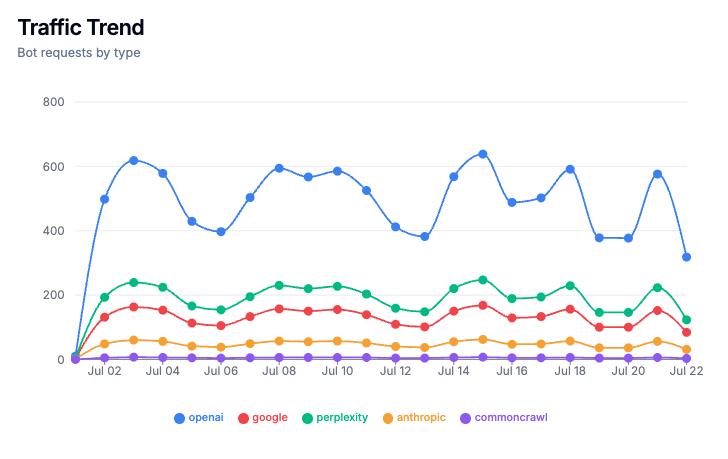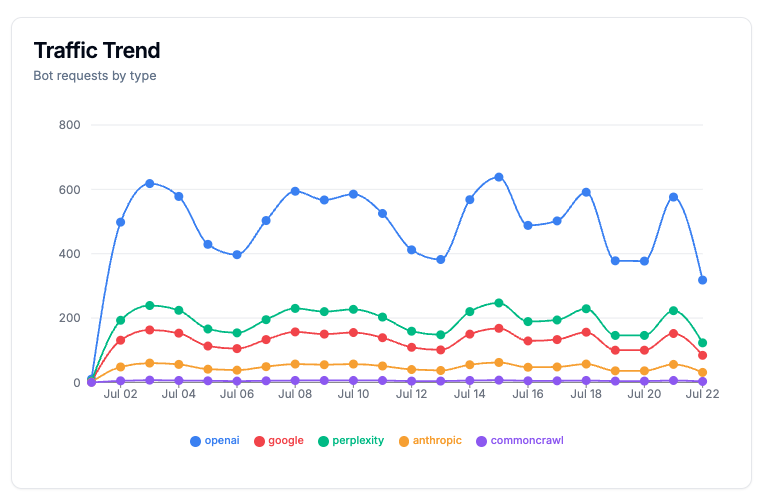How AI Chatbots Actually Learn About Your Product: The New Rules of AI Discovery
GEO Tech

When ChatGPT broke out in Fall 2022, it felt all-knowing. It was trained on nearly the entire internet with a vast knowledge base that could answer almost anything. But there was a catch: that training process took months, leaving the chatbot with knowledge that was almost always 6 months to a year out of date.
Fast forward to 2025, and the capabilities of AI chatbots have dramatically advanced. Modern AI platforms no longer depend solely on static training data. They continuously crawl, fetch, and analyze websites in real time. Understanding how this works isn't just a technical curiosity, it's the foundation of effective AI optimization and a key piece of any Generative Engine Optimization (GEO) strategy.
From Stale Data to Real-Time Intel
The transformation happened in waves. ChatGPT first added search functionality in October 2024, allowing the LLM to reference live internet data when offline knowledge proved inadequate [1]. OpenAI initially partnered with Bing for indexing but has since launched its own web crawler called OAI-SearchBot [2].
The real game-changer came with the rise of AI agents. These autonomous assistants can execute complex tasks by stringing together multiple prompts and taking real-time actions. OpenAI's Operator launched in January, later folding directly into ChatGPT in July [3].
This shift created the need for direct access to the web. This direct access that allows ChatGPT to browse, analyze, and act on current data. One key insight: many of the “Live Fetch” requests are triggered by human usage of ChatGPT and can be used as a proxy for the volume of search interest of the different parts of your product.
Bots at the Door: A Peek at Your New Digital Visitors
Our analysis of early SaaS customers reveals a surprisingly concentrated landscape of crawlers:
| Platform | Bot | Requests | Description |
|---|---|---|---|
| OpenAI | ChatGPT Live Fetch | 54.7% | Real-time page fetching for browsing and current queries |
| Perplexity | PerplexityBot | 23.6% | Live content fetching for search results |
| OpenAI | SearchBot | 4.3% | OpenAI's search indexing bot |
| Apps Script | 4.0% | Automated fetches from integrations | |
| Anthropic | ClaudeBot | 3.4% | Live content for Claude responses |
| Googlebot | 2.6% | Traditional search crawler | |
| Gemini LLM Fetch | 1.9% | Gemini's content fetching bot |
Here's the requests data over time:

Our observations:
- OpenAI dominates: With 60% of total requests across three bots, OpenAI comprises the lion share of bot monitoring.
- Perplexity is disproportionally active: At 25% of traffic, it significantly outperforms its position as only the 4th most popular AI chat app.
- Strong weekday patterns: Looking at the requests by day chart, we can see OpenAI traffic showing clear spikes during business days with weekend lulls, confirming the connection between bot activity and human usage
Where AI Bots Focus Their Attention
Looking at content consumption patterns across B2B SaaS websites reveals surprising priorities:
| Content Type | % of Requests |
|---|---|
| Blog | 76.0% |
| Technical Pages (Robots.txt, etc) | 17.1% |
| Landing Pages | 5.9% |
| Secondary Pages | 1.0% |
The blog dominance insight: The vast majority of AI bot attention goes to blog content, not static website pages. This represents a fundamental shift from traditional SEO thinking.
Strategic opportunities:
- Double down on what works. Analyze common traits between your most crawled posts, such as structure, topics, data usage, and citations. Then replicate those patterns.
- Cross-reference with human traffic: Compare bot activity with Google Analytics data to identify over-indexed content that may indicate high AI training value versus high user query volume.
- Technical optimization matters: Nearly 20% of requests hit technical pages like robots.txt, making proper AI bot configuration + guidance crucial.
- Consider llm.txt implementation: Evidence suggests AI-specific instruction files can provide important context about features and brand positioning [4].
The Strategic Implications for Your Business
This isn't just about traffic, it's about influence. When AI bots crawl your content, they're building the knowledge base that shapes millions of future conversations about your industry, competitors, and solutions.
The compound effect: Unlike traditional SEO, where rankings change gradually, AI knowledge integration can create step-function improvements in brand visibility across entire categories of queries.
The content strategy shift: Optimisation now requires thinking beyond keywords to knowledge representation. How does your content contribute to AI's understanding of your market position? What context helps AI models accurately represent your value proposition?
What This Means for Your AI Strategy
The data reveals three critical areas for immediate focus:
- Content optimization: With 76% of bot traffic hitting blog content, your editorial strategy directly impacts AI knowledge formation. Prioritize comprehensive, authoritative content that positions your expertise clearly within industry context.
- Technical foundation: Proper robots.txt configuration and AI-specific guidance files ensure accessibility while providing crucial context about your product positioning and capabilities.
- Measurement and iteration: Bot traffic patterns offer direct insight into AI interest in your content. Unlike traditional SEO metrics, these signals show real-time AI learning preferences.
So, the question remains, how does you get started with the optimization for web crawlers?
The simplest step is to start by seeing what the bots already know about you and make improvements from there.
GPTrends' Bot Analytics lets you track AI bot activity across your site, uncover patterns, and optimize your content for maximum visibility in AI search resp.
👉🏻 Try GPTrends with a 7-day free: Sign Up
See what the bots see. Start optimizing today.
Citations
[1] The Guardian - OpenAI tests new search engine called SearchGPT amid AI arms race
[2] OpenAI - Help ChatGPT discover your products
[3] OpenAI - Introducing ChatGPT agent: bridging research and action